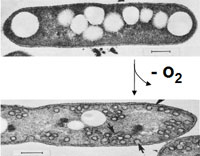| Rhodobacter sphaeroides | |
|---|---|

| |
| Rhodobacter sphaeroides | |
| Scientific classification | |
| Domain: | |
| Phylum: | |
| Class: | |
| Order: | |
| Family: | |
| Genus: | |
| Species: | R. sphaeroides
|
| Binomial name | |
| Rhodobacter sphaeroides (van Niel, 1944) Imhoff et al., 1984
| |
Rhodobacter sphaeroides is a kind of purple bacterium; a group of bacteria that can obtain energy through photosynthesis. Its best growth conditions are anaerobic phototrophy (photoheterotrophic and photoautotrophic) and aerobic chemoheterotrophy in the absence of light.[1] R. sphaeroides is also able to fix nitrogen.[2] It is remarkably metabolically diverse, as it is able to grow heterotrophically via fermentation and aerobic and anaerobic respiration. Such a metabolic versatility has motivated the investigation of R. sphaeroides as a microbial cell factory for biotechnological applications.[3]
Rhodobacter sphaeroides has been isolated from deep lakes and stagnant waters.[2]
Rhodobacter sphaeroides is one of the most pivotal organisms in the study of bacterial photosynthesis. It requires no unusual conditions for growth and is incredibly efficient. The regulation of its photosynthetic machinery is of great interest to researchers, as R. sphaeroides has an intricate system for sensing O2 tensions.[4] Also, when exposed to a reduction in the partial pressure of oxygen, R. sphaeroides develops invaginations in its cellular membrane. The photosynthetic apparatus is housed in these invaginations.[4] These invaginations are also known as chromatophores.
The genome of R. sphaeroides is also somewhat intriguing. It has two chromosomes, one of 3 Mb (CI) and one of 900 Kb (CII), and five naturally occurring plasmids. Many genes are duplicated between the two chromosomes but appear to be differentially regulated. Moreover, many of the open reading frames (ORFs) on CII seem to code for proteins of unknown function. When genes of unknown function on CII are disrupted, many types of auxotrophy result, emphasizing that the CII is not merely a truncated version of CI.[5]
- ^ Mackenzie C, Eraso JM, Choudhary M, Roh JH, Zeng X, Bruscella P, et al. (2007). "Postgenomic adventures with Rhodobacter sphaeroides". Annu Rev Microbiol. 61: 283–307. doi:10.1146/annurev.micro.61.080706.093402. PMID 17506668.
- ^ a b De Universiteit van Texas over Rhodobacter sphaeroides Archived 2009-07-10 at the Wayback Machine
- ^ Orsi E, Beekwilder J, Eggink G, Kengen SW, Weusthuis RA (2020). "The transition of Rhodobacter sphaeroides into a microbial cell factory". Biotechnology and Bioengineering. 118 (2): 531–541. doi:10.1002/bit.27593. PMC 7894463. PMID 33038009.
- ^ a b Oh, JI.; Kaplan, S. (Mar 2001). "Generalized approach to the regulation and integration of gene expression". Mol Microbiol. 39 (5): 1116–23. doi:10.1111/j.1365-2958.2001.02299.x. PMID 11251830. S2CID 27053575.
- ^ Mackenzie, C; Simmons, AE; Kaplan, S (1999). "Multiple chromosomes in bacteria. The yin and yang of trp gene localization in Rhodobacter sphaeroides 2.4.1". Genetics. 153 (2): 525–38. doi:10.1093/genetics/153.2.525. PMC 1460784. PMID 10511537.